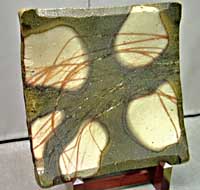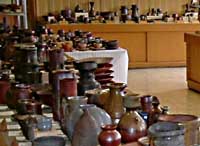|

Click here for
index to all
Yellin stories for
The Japan Times
Click for another
story about
Isezaki Jun
LEARN MORE
What is Bizen?

Yellin's gallery
sells pieces from
the kilns of Japan's
finest potters |
|
|
National Treasures
of Bizen-Ware Pots
By ROBERT YELLIN
for the Japan Times, August 11, 2004
|
|

Large plate by Isezaki Jun.
Isezaki is was recently named
a Living National Treasure
for Bizen pottery.
Now on display at
Bizen Ceramic Museum
Imbe Station Gallery
Bizen Ceramic Museum
TEL (0869) 64-1400
Open 9:30 am, Close 5:00 pm
Closed on Mondays
Admission 500 yen for adults
|
|
|

Photos by Robert Yellin
|
|
|
|
|
The city and pottery style of Bizen hold a special place in my heart; in a sense, Bizen was my "first love" in the ceramic world. When I was first given a Bizen yunomi (tea cup) twenty years ago I had never held something so earthy and "alive" -- a vessel for use in daily life, to enhance drinking pleasure, and "deepen" my inner self. It taught me Japanese aesthetic terms such as wabi-sabi , jimi and shibui, and it led me to learn about Japan's ceramic history and culture. The small yunomi became like a mentor to me.
Others around Japan, and the world, must feel the same as I do for Bizen, as it's one of Japan's most vibrant and vital ceramics, with more collectors than any other style. The small city is a joy to visit and, more than any other ceramic town, easy to get around. A day spent walking the narrow roads will bring one in touch with ancient masterpieces, old kiln sites and the works of the hundreds of potters working in the area.
Bizen pottery is an unglazed, high-fired stoneware. Its decorative effects all come from the iron-rich clay, red pine ash and wrapped straw cords, which fire off and leave brilliant red streaks. It has a quiet and refined natural quality, found in no other Japanese ceramic center. Bizen's train station is called Imbe, and is located about 35 minutes from Okayama station on the Ako line. Be sure to pick up a map of the area at Imbe station (English translations are available). This will guide you to the many potters within walking distance, quite a number of whom have showrooms and do not require appointments.
The station building houses a large gallery on the second floor, where one is almost overwhelmed by the variety of works on display. It's a good place to allow the eye to adjust to the myriad tones and forms that abound. Then walk on over to the four-story ceramic museum next to the station, to learn about history and see examples of classical Ko-Bizen (old Bizen), dating from the Heian to the mid-Edo period. The Bizen Ceramic Museum is open from 9:30 am to 5:00 pm. See above photos for contact data.
Works by modern and contemporary Bizen potters are also on display. Before heading to the museum, be sure not to miss the animated shishi -- mythical lion relief -- on the station's outer walls, created by Okayama Prefecture Intangible Cultural Property Urakami Zenji.
Immediately in front of the station, across busy Route 2, is a road lined with shops -- the better ones being Omori on the corner and the Bizen Tougei Kurabu, a little further along on the right. Also on Route 2, to the left of the station, is Beppu, which always has a good selection too. Their Japanese Web site is www.g-beppu.com.
Like many other potting towns in Japan, Bizen runs a brisk tourist trade. Yet souvenir works are easily tired of, and don't always show the true beauty of Bizen. My advice is to buy from well-established shops, like the ones mentioned above and the station gallery, or older production kilns like Konishi Toko and Kimura Ichiyo (all listed on the guide map).
Bizen boasts more Living National Treasures than any other ceramic style -- four in the past and a new one designated just last month. The original four were Kaneshige Toyo (1896-1967), Fujiwara Kei (1899-1983), Yamamoto Toshu (1906-1994) and Fujiwara Yu (1932-2001). Kaneshige was instrumental in revitalizing Bizen in the early 20th century. He alone is responsible for the healthy state of Bizen today.
The question that has lingered for years in the ceramic world here: "Who will be next?" has finally been answered. Some thought it might be the man currently constructing the world's largest anagama (single tunnel kiln), which runs to an amazing 90 meters, the fabled Mori Togaku. Others were holding out for the younger "giant," who has created an entirely new vision for Bizen -- the charismatic Kakurezaki Ryuichi. Other names heard floating in the wind have been Matsui Tomoyuki, Yamamoto Yuichi, and the brothers Isezaki Mitsuru and Isezaki Jun; the highest honor in has been bestowed upon the younger brother, Jun.
Isezaki Jun (1936-) is one of Bizen's most dynamic veteran potters. Long before the rest, he succeeded in bringing to his work a sharp balance between the functional and the purely sculptural. (See "LEARN MORE" section at bottom of page to learn more about Isezaki Jun.)
He is also a dedicated teacher, whose students have included Kakurezaki, Shibaoka Koichi, Wakimoto Hiroyuki and many, many foreign potters as well. He's served his time on regional art committees and needless to say has the right connections. But, all-in-all, his work has been groundbreaking, and includes his unique botomochi shapes (botomochi are the roundels on ceramics, where a "cracker" was placed to block the flame and ash, thus creating a "rice cake" design), his large "Black Sun" series of the 70s-80s, and his Bizen murals. In the early 1960s, he also reintroduced a medieval-style anagama to Bizen. His work can be seen scattered throughout the town, and was previously reviewed in this column.
In Tokyo, there are many fine Bizen specialist galleries. One of the better ones is Bizen Gallery Aoyama. Their bilingual Web site is: bizenpottery.com.
The Japan Times: Aug. 11, 2004
(C) All rights reserved
LEARN MORE
|
|
|